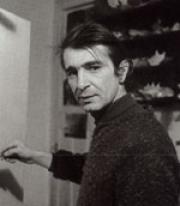
Eduard Arkadevich Steinberg is one of the major non-conformist artists, the most striking representatives of the second wave of the Russian avant-garde. His creative journey began in the middle of the 1950’s with the use of realistic objects. Tarusa, just outside Moscow, is a reference point in his painting. For over five years he worked from nature, painted landscapes in Tarusa, still-lifes and portraits of friends. Latterly, he moved onto ‘metaphysical still-lifes’, characterised by a lighter tone. The ‘classic Steinberg’ was developed under the crucial influence of Malevich: by retaining the overall impression that his flying forms are hovering in space, the young artist reduced to a minimum the sharp contrasts in colour, inherent in the original suprematism, giving his forms a likeness to a melancholic ‘memory of the avant-garde’. These paintings developed into a series spanning many years, elegant in its modelling of form and full of subtle decorative intuition. His abstract pieces are dominated by calm and eternity, rather heavy planes of colour and well-pressed lines; he loves white on white and black on brown, and for him a tense diagonal or a tragically broken circle are a luxury. In Eduard Steinberg’s landscapes, the abstract does not conflict with the concrete, the figurative elements can be read as symbols of reality, abstract spirts. As well as painting, Eduard Steinberg’s creative works also include gouaches and collages on cardboard. In a creative dialogue with the Moscow conceptualism of/from the middle of the 1980’s, he introduces captions and a narrative beginning to his works.